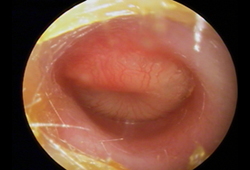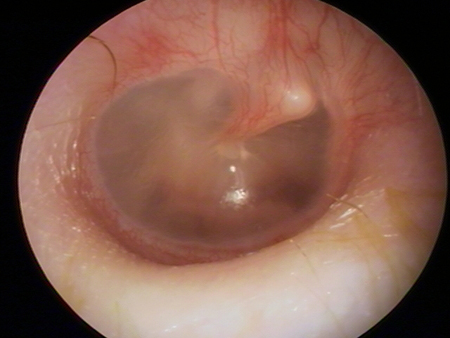Differentials
Acute otitis media
SIGNS / SYMPTOMS
The middle ear effusion of acute otitis media is associated with rapid onset of signs and symptoms of infection, such as fever, ear pain, discharge from the ear, rhinorrhoea, congestion, and cough. There may also be ear pain and discharge from the ear.
Significant otalgia is more likely than with OME. In the setting of tympanic membrane perforation related to acute otitis media, there will also be otorrhoea.
INVESTIGATIONS
On otoscopy the tympanic membrane will appear opaque, bulging, and inflamed with erythema, and there will be a purulent middle ear effusion. If there is a tympanic membrane perforation, purulent otorrhoea will be seen.[Figure caption and citation for the preceding image starts]: Otoscopy appearance of a bulging, erythematous tympanic membrane and absent landmarksFrom the personal collection of Dr Armengol [Citation ends]. Normal pure tone thresholds with audiological testing unless the drum is very thickened with inflammation.
Normal pure tone thresholds with audiological testing unless the drum is very thickened with inflammation.
The tympanic membrane and middle ear will show normal compliance on tympanometry.
Myringitis
SIGNS / SYMPTOMS
These patients may have no symptoms attributable to the middle ear, or mild pain. Myringitis can be seen as part of the evolution of acute otitis media.
INVESTIGATIONS
On otoscopy there is erythema and injection of the tympanic membrane in the neutral position without other features of otitis media.[63]
[Figure caption and citation for the preceding image starts]: Otoscopy of myringitis, showing erythema and injection of the tympanic membrane in the neutral positionFrom the personal collection of Dr Armengol [Citation ends].
Dilatory Eustachian tube dysfunction
SIGNS / SYMPTOMS
Symptoms include ear pain, ear popping and muffled hearing.[51]
Older children and adults may report trying to equalise negative ear pressure via autoinsufflation or opening and closing the jaw, ear 'popping', or yawning.
INVESTIGATIONS
On otoscopy normal landmarks such as the short process of the malleus appear more prominent, as seen in chronic OME, but there is no middle ear effusion in patients with Eustachian tube dysfunction.
Tympanometry typically yields a type C trace, suggesting negative pressure.
[Figure caption and citation for the preceding image starts]: Type C tympanogram, demonstrating a malfunctioning Eustachian tubeFrom the collection of Erica R. Thaler; used with permission [Citation ends].
Patulous Eustachian tube dysfunction
SIGNS / SYMPTOMS
Patients with an abnormally patent Eustachian tube typically experience autophony, which may improve in the supine position or with an upper respiratory tract illness.[51]
The patient may report weight loss or radiation exposure.
While this condition is separate from classic dilatory Eustachian tube dysfunction, it is worth actively considering, particularly as there may be overlapping symptoms of aural fullness or pressure in adults.
INVESTIGATIONS
On otoscopy the tympanic membrane may move in concert with respiration, particularly if the patient is upright.[64]
Cholesteatoma
SIGNS / SYMPTOMS
Cholesteatoma may be congenital or acquired. In either case, the presentation may range from subtle symptoms such as hearing loss to more significant symptoms such as chronic otorrhoea, pain, vertigo, and facial nerve paresis.
INVESTIGATIONS
On otoscopy, you may see drainage, a retraction pocket, or perforation with granulation or squamous debris, or a white mass in or behind the tympanic membrane.
Use of this content is subject to our disclaimer